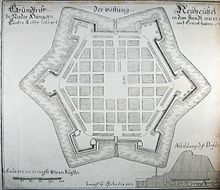| Revision as of 20:16, 21 April 2008 editNmate (talk | contribs)Pending changes reviewers5,033 edits →History: strong Magyarization in Trnava? All right!← Previous edit | Revision as of 10:07, 22 April 2008 edit undoTankred (talk | contribs)7,836 edits Original research used as spill-over of edit warring from Trnava rv.Next edit → | ||
| Line 105: | Line 105: | ||
| ] | ] | ||
| After break-up of ] in 1918/1920, the town became part of newly created Czechoslovakia. As a result of the ], it was |
After break-up of ] in 1918/1920, the town became part of newly created Czechoslovakia. As a result of the ], it was occupied by ] between 1938 and 1945. Finally, during ] (]), the town was heavily damaged by bombings of the ]. Only small parts of the fortress are still standing today. It is, however, still depicted on the city's coat of arms (see above). | ||
| ==Demographics== | ==Demographics== | ||
Revision as of 10:07, 22 April 2008
Nové Zámky (pronunciation; Template:Lang-hu, Template:Lang-de, Template:Lang-tr, Template:Lang-la) is a town in south-western Slovakia.
Geography
The town is located on the Danubian Lowland, on the Nitra River, at an altitude of 119 metres. It is located around 100 km from Bratislava and around 25 km from the Hungarian border. It is a road and railway hub of southern Slovakia.
The town lies in the temperate zone and has a continental climate. Annual average temperature reaches around 10 °C (50.0 °F), with the warmest month being July with an average of 20 °C and the coldest January with -2 °C. Average annual precipitation is 556 mm.
History
The town is famous for its history. A fortress was built, against the Ottoman Turks, on the site of an older settlement in the years 1573-81. The town developed around the fortress. The huge new fortress was one of the most modern fortresses in Europe when it was built, a prime example of the star fortress which was considered to be adapted to the advance in artillery in the preceding centuries.
The Turks failed to conquer it six times, but in 1663 they managed to do so. It was made the center of a Turkish province, the Uyvar eyalet in present-day southern Slovakia - with the subordinate sanjaks of Litra, Leve, Novigrad, Holok, Bukabak and Şefradi (probably Šahy).
The still common saying "Strong as a Turk in front of Nové Zámky", which means working with determination and stability, reflects the memory of conquest determination of the Turks.
In 1685 it was conquered by the imperial troops of Charles of Lorraine. Six years later, it received town privileges from the Esztergom archbishop.
The town also played an important role in many anti-Habsburg uprisings in the northern parts of Royal Hungary in the 17th century. Emperor Charles VI had it razed in 1724-1725, to prevent potential further insurrections which would use the fortress as their base.

After break-up of Austria-Hungary in 1918/1920, the town became part of newly created Czechoslovakia. As a result of the First Vienna Award, it was occupied by Hungary between 1938 and 1945. Finally, during World War II (1944), the town was heavily damaged by bombings of the Allies. Only small parts of the fortress are still standing today. It is, however, still depicted on the city's coat of arms (see above).
Demographics
The 2001 census recorded a population of 42 262 people, with 69.67% of them being Slovaks, 27.52% Hungarians and others. The most widespread religion was Roman Catholicism (71.72%), followed by a group without denomination (17.75%) and Evangelics (3.36%).
Year
|
Population |
Year |
Population |
1200 |
10 584 | ||
1525 |
11 299 | ||
2970 |
13 204 | ||
3873 |
16 228 | ||
4671 |
23 306 | ||
5167 |
13 400 | ||
5493 |
18 710 | ||
5957 |
20 031 | ||
6904 |
22 041 | ||
6936 |
23 457 | ||
7622 |
42 923 | ||
9483 |
42 262 |
Ethnic comparison:
Year | ||||||||
61% |
46% |
71% |
91.43% |
45% |
88% |
31.10% |
27.50% | |
25% |
36% |
8% |
5.94% |
42% |
9.5% |
66.82% |
69.70% | |
13% |
17% |
4% |
2% |
- |
- |
- |
<0.1% | |
- |
- |
3% |
- |
- |
- |
- |
0.80% | |
- |
- |
13% |
8,48% |
8% |
- |
- |
0,4% | |
Famous people
- Anton Bernolák, linguist
- Ferenc Helbing, graphic artist
- Lajos Kassák, poet
- Henrieta Nagyová, tennis player
- Martina Suchá, tennis player
Partner towns
 Znojmo, Czech Republic
Znojmo, Czech Republic Fonyód, Hungary.
Fonyód, Hungary.